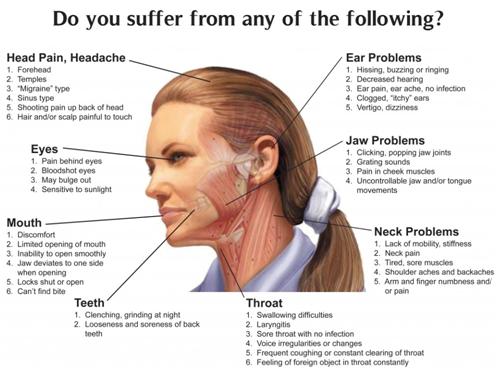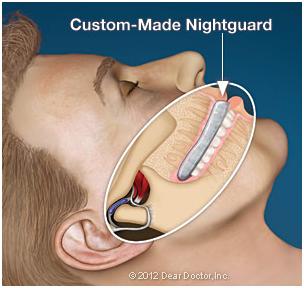The fall harvest season is upon us, meaning it’s time to get cooking with some of the season’s fresh harvest pickings. If however, you’re biting down on that corn on the cob and noticing your jaw hurts, take care to identify whether you’ve actually got a more serious medical condition. The jaw is one of the most powerful systems in our body – and one of the most important. As such an industrious worker however, it’s quite possible to cause strain to this critical joint, ultimately leading to a host of other oral and physical health problems. The technical term for these kinds of issues is temporomandibular joint syndrome, named for the joint that links your jawbone to your skull. It’s more commonly referred to as TMJ syndrome.

What are the symptoms of TMJ disorder?
Take a moment to find your temporomandibular joint with your fingers by lightly pressing a few fingers to the space right in front of your earlobes. If you have TMJ, chances are you feel some sensitivity or swelling in that area, or throughout your jaw in general, particularly when chewing. Of course, TMJ can lead a host of other symptoms that impact your vision, hearing, and muscle pain in your face and neck. If you find your jaw is clicking or popping, or you have ear pain, these symptoms can all be the result of an irritated TMJ. What’s interesting is some physical pain we experience and may chalk up to dozens of other factors can also be symptoms of TMJ syndrome. Chronic headaches, tight muscles in your neck and shoulders, and even blurry vision can all tie back to an inflamed TMJ.

What causes TMJ syndrome?
There isn’t one clear reason why some people get TMJ syndrome and why others don’t. That being said, one consistent factor is poor jaw alignment, which essentially causes all of the muscles and bones in your mouth to work that much harder to chew, swallow, and speak. Many people who suffer from TMJ syndrome may also be coping with high levels of stress, have poor posture, or may have another condition, such as arthritis, that is causing inflammation within their jaw. TMJ disorders are commonly found in women aged 18-40, but they can occur at any age, amongst both men and women.

How can I relieve the symptoms of my TMJ disorder?
The first step is to get an official diagnosis from your dentist, who may refer you to a jaw specialist if need be. The good news is there are plenty of holistic choices to help resolve your TMJ issues, apart from painkillers or sedatives. Below are just some of the natural ways to help minimize your TMJ pain. While most TMJ cases can be resolved on their own, in some extreme cases – particularly if you don’t take steps to help address what’s causing your TMJ – jaw surgery may be required.
Freeze the Joint: Applying an ice pack a few times per day can help soothe your TMJ. Conversely, heat from a source like a water bottle may also help.
Watch What You Eat: One other possible trigger for TMJ is excessive gum chewing, which puts excessive strain on your muscles and joints. Take a break from chewing gum and stick to softer foods if you find your jaw is tight.
Massage and Stretching: Indulge in some gentle self-stretching techniques to help keep your jaw muscles loose and limber. You may also want to visit a physiotherapist or registered massage therapist for a targeted massage that relieves tension in your shoulders, neck and jaw.

Oral Splints (Bite Guards): In many cases, a soft, custom-built bite guard or splint can help relieve TMJ systems. A splint will help keep your teeth in alignment and prevent tooth grinding – both of which are key aggravators that can lead to TMJ disorders.
SOURCES:
http://www.medicinenet.com/temporomandibular_joint_syndrome_tmj/article.htm
http://www.emedicinehealth.com/temporomandibular_joint_tmj_syndrome/page10_em.htm#tmj_syndrome_prognosis
http://www.mayoclinic.org/diseases-conditions/tmj


